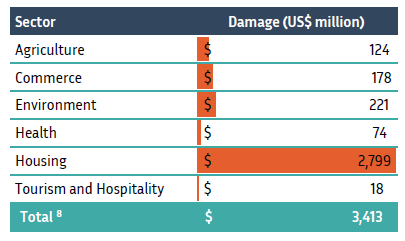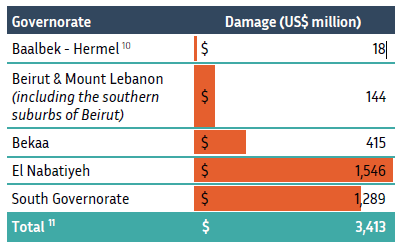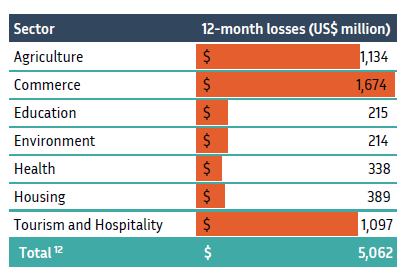


Note: Damage to commerce, health, housing, and tourism and hospitality are assessed based on data as of October 27, 2024, while damage to agriculture and environment are assessed based on data as of September 27, 2024.
The World (WB) published on November 14, 2024, The Lebanon Interim Damage and Loss Assessment (DaLA). The report “draws on remote data sources and analytics to assess physical damage and economic losses across seven key sectors. The damage assessment covers the six most conflict-affected governorates, while economic losses are assessed nationwide whenever data allows. Data collection was finalized as of October 27th for four sectors covered (commerce, health, housing, tourism/hospitality) and as of September 27th for the other three (agriculture, education, environment)”.
The cost of physical damages and economic losses due to the conflict in Lebanon is estimated at $8.5 billion. In details, the damages to physical structures or assets amount to $3.4 billion; and that of economic or income losses to $5.1 billion over a year from the cut-off dates (mainly October, 2024)
In terms of sectors, “Housing has been the hardest hit sector, with almost 100,000 housing units partially or fully damaged, amounting to $3.2 billion in damages and losses. Disruptions to commerce are amounting to close to $1.9 billion, driven in part by the displacement of employees and business owners. The destruction of crops, livestock and the displacement of farmers has driven agricultural losses and damages of about $1.3 billion”.
As to macroeconomic performance, the report claims that the conflict is estimated to have cut Lebanon’s real GDP growth by at least 6.6 percent in 2024. That is real GDP is projected to contract by at least 5.7 percent in 2024, compared to a counterfactual scenario without conflict in which real GDP growth would have been 0.9 percent. This compounds five years of sustained sharp economic contraction that has exceeded 34% of real GDP. The report also looks at the impact of the conflict on the people of Lebanon. There are over “875,000 internally displaced persons in Lebanon, with women, children, the elderly, persons with disabilities, and refugees at highest risk. An estimated 166,000 individuals have lost their jobs, corresponding to a loss of $168 million in earnings”.
The report, however, notes, that “given that the conflict is ongoing with damage already observed beyond the sector cut-off dates for this assessment, and that losses will likely accumulate over a longer period than the assessment considers, estimates presented are likely to be conservative”.
Lastly, The DaLA findings will “contribute to a more comprehensive Rapid Damage and Needs Assessment (RDNA) to be conducted by the World Bank in collaboration with the Government of Lebanon, the EU, UN agencies, and other development partners once the situation allows and the government indicates its readiness to proceed. This RDNA will encompass the entire country, provide a full assessment for all impacted sectors (including needs), and develop recovery options for all sectors, culminating in a sequenced and prioritized reconstruction and recovery strategy”.
Disclaimer:
This article is a research document that is owned and published by Blominvest Bank SAL.
No material from this publication may be modified, copied, reproduced, repackaged, republished, circulated, transmitted or redistributed directly or indirectly, in whole or in any part, without the prior written authorization of Blominvest Bank SAL.
The information and opinions contained in this document have been compiled from or arrived at in good faith from sources deemed reliable. Neither Blominvest Bank SAL, nor any of its subsidiaries or affiliates or parent company will make any representation or warranty to the accuracy or completeness of the information contained herein.
Neither the information nor any opinion expressed in this research article constitutes an offer or a recommendation to buy or sell any assets or securities, or to provide investment advice.
This research article is prepared for general circulation and is circulated for general information only.